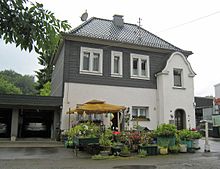Hommerich
|
Hommerich
municipality Lindlar
Coordinates: 51 ° 0 ′ 28 ″ N , 7 ° 17 ′ 5 ″ E
|
||
|---|---|---|
| Height : | 135 m above sea level NN | |
| Residents : | 160 (December 31, 2011) | |
| Postal code : | 51789 | |
| Primaries : | 02266, 02207 | |
|
Location of Hommerich in Lindlar |
||
|
View of the town of Hommerich
|
||
Hommerich is a district of the municipality of Lindlar , Oberbergischer Kreis , in the administrative district of Cologne in North Rhine-Westphalia .
Location and description
Hommerich is located in the west of the municipality of Lindlar in the Sülztal. The municipal and district border to the municipality of Kürten and the Rheinisch-Bergischen district runs near Hommerich . At Tüschen, the Lindlar and Kürten Sülz combine to form Sülz .
history
In 1487 the place was mentioned for the first time "in a document" as homberg . The name is derived from "homer", the raspberry.
In the Middle Ages, Hommerich belonged to the Tüschen community in the parish of Hohkeppel .
Industrialization began in the Sülztal in the 18th century when Christian Hamm started up an iron hammer in Welzen. For this purpose, various people resident in Hommerich also sold properties.
In 1830 there were 24 people living in Hommerich. Hommerich belonged to the municipality of Hohkeppel until 1975.
During the Second World War there was a POW camp in Hommerich. Initially, French prisoners of war were interned here to maintain and repair the railway. This camp gained notoriety especially from 1941, when 98 Soviet prisoners of war replaced the French in the camp. The camp manager August Fuchs ruthlessly urged the Soviet prisoners of war to work and, among other things, denied them straw for their storage or food. The numerous deaths were also known in the area. Despite the sharpest protests of the parish rector of Offermannsheide and the local group leader Ossenbach, 42 Soviet citizens died in Hommerich. They were buried at night and in fog on a pasture in Ebbinghausen or in the cemetery in Hohkeppel.
Due to § 10 and § 14 of the Cologne Act , the municipality of Hohkeppel was dissolved in 1975 and extensive parts of Lindlar were incorporated. Including Hommerich.
economy
There is an old industrial area in Lindlar in Hommerich. Until the 1990s, the Hommerich dairy , later Tuffi-Werke , was a major employer. Campina took over the works and shut down the dairy plant. The milk drying plant will be continued by EUROLAT GmbH.
There is also a building materials trade and a natural stone trade in town. The former administration building of the Tuffi-Milchwerke was renovated. Smaller craft firms are based here.
traffic
bus connections
Hommerich stop :
Hommerich-Schmitte stop :
- VRS ( KWS ) line 401 industrial area Klause - Lindlar - Schmitzhöhe - Kürten school center (only school traffic)
- VRS (KWS) line 408 Kürten - Offermannsheide - Biesfeld - Kürten (school traffic only)
Former railway line
The extension of the Cologne-Mülheim-Lindlar line on the Immekeppel - Lindlar section was a long time coming. In January 1912, the Immekeppel – Hommerich section was completed. The section from Hommerich to Lindlar was last opened in December 1912. The end came in 1960 for passenger trains. Freight traffic came to a standstill in 1966. In the same year the tracks were dismantled on the entire section.
Individual evidence
- ^ Klaus Pampus: First documentary naming of Oberbergischer places (= contributions to Oberbergischen history. Sonderbd. 1). Oberbergische Department 1924 eV of the Bergisches Geschichtsverein, Gummersbach 1998, ISBN 3-88265-206-3 .
- ↑ on the trial against Fuchs see: LG Cologne, October 19, 1951 . In: Justice and Nazi crimes . Collection of German criminal convictions for Nazi homicides 1945–1966, Vol. VIII, edited by Adelheid L. Rüter-Ehlermann, HH Fuchs, CF Rüter . Amsterdam: University Press, 1972, No. 294, pp. 763–782. Abuse of Russian prisoners of war and shooting of a prisoner of war for alleged disobedience ( Memento of December 3, 2016 in the Internet Archive )
- ^ The Cologne Act in full. Retrieved June 7, 2016 .
- ↑ Bernd Franco Hoffmann: The Sülztalbahn , ed. Geschichtsverein Rösrath e. V., Rösrath 2012, p. 104 ff. ISBN 978-3-922413-65-3



